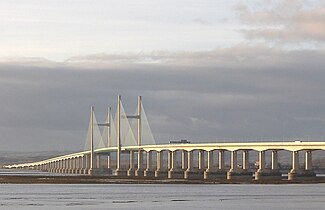 The bridge as viewed from Severn Beach (England) | |
| Coordinates | 51°34′28″N 2°42′06″W / 51.5745°N 2.7016°W |
| Carries | |
| Crosses | River Severn |
| Locale | South West England / South East Wales |
| Official name | Prince of Wales Bridge (since 2 July 2018) |
| Other name(s) | Welsh: Ail Groesfan Hafren or Pont Tywysog Cymru |
| Named for | River Severn or Charles, Prince of Wales |
| Maintained by | National Highways[1][2] |
| Characteristics | |
| Design | Central span: Cable-stayed bridge Approach viaducts: Segmental bridge |
| Total length | 5,128 metres (16,824 ft) |
| Width | 34.6 metres (113.5 ft) |
| Height | 137 metres (449 ft) |
| Longest span | 456 metres (1,496 ft) |
| Clearance below | 37 metres (121 ft) |
| History | |
| Architect | Ronald Weeks of the Percy Thomas Partnership |
| Engineering design by | Halcrow Group and SEEE |
| Opened | 5 June 1996 |
| Statistics | |
| Daily traffic | 61,455 (2008)[3] |
| Toll | Free |
| Location | |
 | |

The Second Severn Crossing (Welsh: Ail Groesfan Hafren), officially named the Prince of Wales Bridge (Welsh: Pont Tywysog Cymru) since July 2018, is the M4 motorway bridge over the River Severn between England and Wales, opened in 1996 to supplement the traffic capacity of the Severn Bridge built in 1966. The bridge is operated by England's National Highways. It has a total length of 5,128 metres (16,824 ft).
It is southwest of the Severn Bridge and because it is more closely in line with the rest of the M4, it reduces the length of the journey between England and Wales. The junctions at each end are designed for most traffic to use this crossing, and in order to use the old Severn Bridge, one has to leave the M4 at junction 21 and join the M48 near Aust or at junction 23 near Magor. The new crossing carries more traffic than the Severn Bridge, which is still in use. It is wider than the Severn Bridge, having three lanes and a narrow hard shoulder each way, compared to the two lanes, cycle path and narrow footpath of the original crossing. It is a cable-stayed bridge, whereas the Severn Bridge is a suspension bridge. The position of the bridge is close to that of the Severn Tunnel, which has carried the railway line beneath the river bed since 1886.
Much of the estuary is mudflats at low tide, but at high tide these can be covered by as much as 14 metres (46 ft) of water. This presented the engineers with a constraint: packets of work were scheduled at low tide, and needed to be completed within the short windows allowed by the tides.
The concession given to the consortium which financed, built and operate the bridge required them to take over the outstanding debt on the original Severn Bridge and to operate the two bridges as a single entity. Tolls were set annually by the government based on the previous year's change in the Retail Price Index. On the expiry of the concession in January 2018, the consortium was required to hand the bridge over to public ownership. The tolls on both bridges were subsequently scrapped in December 2018.
- ^ "Highways England network management" (PDF). gov.uk. Highways England. Retrieved 22 April 2019.
- ^ "Severn Bridges will be owned by the government from tomorrow as tolls to be scrapped in 2018". Bristol Post. Trinity Mirror. 7 January 2018. Retrieved 22 April 2019.
- ^ "The Impact of the Severn Tolls on the Welsh Economy" (PDF). Welsh Government. Retrieved 5 March 2021.